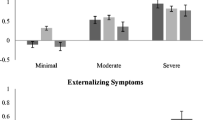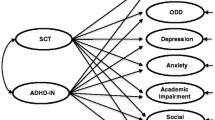Abstract
Sluggish cognitive tempo (SCT) has been proposed as a unique syndrome; however research examining how it is different from attention-deficit/hyperactivity disorder (ADHD) is just starting to emerge. The present study extends this research by examining how specific personality features (i.e., psychopathy) may mediate the relation between ADHD and social problems, but not between SCT and social problems. Caregivers of 198 children (6–12 years old) that presented for an inpatient psychiatric evaluation completed standardized measures of childhood behavior problems. Bootstrapped mediational analyses were performed to evaluate the mediating role of psychopathy on the relation between social problems and symptoms of ADHD versus SCT. Two sub-domains of psychopathy—impulsivity and narcissism—emerged as partial mediators for the relation between social problems and ADHD symptoms; whereas SCT symptoms were not found to be related to psychopathy after controlling for ADHD symptoms. These findings provide support for conceptualizing ADHD and SCT as discrete syndromes as well as for the mediating role of psychopathy domains on the risk of social problems among a clinical sample of youth with symptoms of ADHD.

Similar content being viewed by others
References
American Psychiatric Association (2013) Diagnostic and statistical manual of mental disorders: DSM-5, 5th edn. American Psychiatric Publishing Inc, Arlington
Bagwell CL, Molina BG, Pelham WE, Hoza B (2001) Attention-deficit hyperactivity disorder and problems in peer relations: predictions from childhood to adolescence. J Am Acad Child Adolesc Psychiatry 40:1285–1292
DuPaul GJ, McGoey KE, Eckert TL, VanBrakle J (2001) Preschool children with attention-deficit/hyperactivity disorder: impairments in behavioral, social, and school functioning. J Am Acad Child Adolesc Psychiatry 40:508–515
Haas SM, Waschbusch DA, Pelham WR, King S, Andrade BF, Carrey NJ (2011) Treatment response in CP/ADHD children with callous/unemotional traits. J Abnorm Child Psychol 39:541–552
Hodgens J, Cole J, Boldizar J (2000) Peer-based differences among boys with ADHD. J Clin Child Psychol 29:443–452
Hoza B (2007) Peer functioning in children with ADHD. J Pediatr Psychol 32:655–663
Hoza B, Mrug S, Gerdes AC, Hinshaw SP, Bukowski WM, Gold JA (2005) What aspects of peer relationships are impaired in children with attention-deficit/hyperactivity disorder? J Consult Clin Psychol 73:411–423
Maedgen J, Carlson CL (2000) Social functioning and emotional regulation in the attention deficit hyperactivity disorder subtypes. J Clin Child Psychol 29:30–42
McConaughy SH, Volpe RJ, Antshel KM, Gordon M, Eiraldi RB (2011) Academic and social impairments of elementary school children with attention deficit hyperactivity disorder. School Psychol Rev 40:200–225
Mrug S, Hoza B, Pelham WE, Gnagy EM, Greiner AR (2007) Behavior and peer status in children with ADHD: continuity and change. J Atten Disord 10:359–371
Pelham WE, Bender ME (1982) Peer relationships in hyperactive children: description and treatment. In: Gadow K, Bialer I (eds) Advances in learning and behavioral disabilities. JAI Press, Greenwich, pp 1365–1436
Mrug S, Molina BG, Hoza B, Gerdes AC, Hinshaw SP, Hechtman L, Arnold L (2012) Peer rejection and friendships in children with attention-deficit/hyperactivity disorder: contributions to long-term outcomes. J Abnorm Child Psychol 40:1013–1026
Barkley RA (2012) Distinguishing sluggish cognitive tempo from attention-deficit/hyperactivity disorder in adults. J Abnorm Psychol 121:978–990
Lee S, Burns G, Snell J, McBurnett K (2014) Validity of the sluggish cognitive tempo symptom dimension in children: sluggish cognitive tempo and ADHD-inattention as distinct symptom dimensions. J Abnorm Child Psychol 42:7–19
Becker SP, Langberg JM (2013) Sluggish cognitive tempo among young adolescents with ADHD: relations to mental health, academic, and social functioning. J Atten Disord 17:681–689
Becker SP, Luebbe AM, Fite PJ, Stoppelbein L, Greening L (2014) Sluggish cognitive tempo in psychiatrically hospitalized children: factor structure and relations to internalizing symptoms, social problems, and observed behavioral dysregulation. J Abnorm Child Psychol 42:49–62
Carlson CL, Mann M (2002) Sluggish cognitive tempo predicts a different pattern of impairment in the attention deficit hyperactivity disorder, predominantly inattentive type. J Clin Child Adolesc Psychol 31:123–129
Watabe Y, Owens JS, Evans SW, Brandt NE (2014) The relationship between sluggish cognitive tempo and impairment in children with and without ADHD. J Abnorm Child Psychol 142:105–115
Ang RP, Tan KA, Mansor AT (2011) Normative beliefs about aggression as a mediator of narcissistic exploitativeness and cyberbullying. J Interpers Violence 26:2619–2634
Seah SL, Ang RP (2008) Differential correlates of reactive and proactive aggression in Asian adolescents: relations to narcissism, anxiety, schizotypal traits, and peer relations. Aggr Beh 34:553–562
Barry CT, Frick PJ, Adler KK, Grafeman SJ (2007) The predictive utility of narcissism among children and adolescents: evidence for a distinction between adaptive and maladaptive narcissism. J Child Fam Stud 16:508–521
Lynam DR (1996) Early identification of chronic offenders: who is the fledgling psychopath? Psychol Bull 120:209–234
Frick PJ, Bodin SD, Barry CT (2000) Psychopathic traits and conduct problems in community and clinic-referred samples of children: further development of the psychopathy screening device. Psychol Assess 12:382–393
Frick PJ, Hare RD (2001) Antisocial process screening device. Multi-Health Systems Inc, North Tonawanda
Piatigorsky A, Hinshaw SP (2004) Psychopathic traits in boys with and without attention-deficit/hyperactivity disorder: concurrent and longitudinal correlates. J Abnorm Child Psychol 32:535–550
Pardini DA, Fite PJ (2010) Symptoms of conduct disorder, oppositional defiant disorder, attention-deficit/hyperactivity disorder, and callous-unemotional traits as unique predictors of psychosocial maladjustment in boys: advancing an evidence base for DSM-V. J Am Acad Child Adolesc Psychiatry 49:1134–1144
Mathias CW, Furr RM, Daniel SS, Marsh DM, Shannon EE, Dougherty DM (2007) The relationship of inattentiveness, hyperactivity, and psychopathy among adolescents. Pers Individ Dif 43:1333–1343
Colledge E, Blair RJR (2001) The relationship in children between the inattention and impulsivity components of attention deficit and hyperactivity disorder and psychopathic tendencies. Pers Individ Dif 30:1175–1187
Nigg JT (2006) Temperament and developmental psychopathology. J Child Psychol Psychiatry 47:395–422
Baron RM, Kenny DA (1986) The moderator-mediator variable distinction in social psychological research: conceptual, strategic, and statistical considerations. J Pers Soc Psychol 51:1173–1182
Achenbach TM, Rescorla L (2001) Manual for the ASEBA school-age forms & profiles. University of Vermont Research Center for Children, Youth, & Families, Burlington, VT
Skirbekk B, Hansen B, Oerbeck B, Kristensen H (2011) The relationship between sluggish cognitive tempo, subtypes of attention-deficit/hyperactivity disorder, and anxiety disorders. J Abnorm Child Psychol 39:513–525
Shrout PE, Bolger N (2002) Mediation in experimental and nonexperimental studies: new procedures and recommendations. Psychol Methods 7:422–445
Hayes AF (2013) Introduction to mediation, moderation, and conditional process analysis: a regression-based approach. Guilford Press, New York
Fairchild AJ, MacKinnon DP, Taborga MP, Taylor AB (2009) R2 effect-size measures for mediation analysis. Behav Res Methods 41:486–498
Kimonis ER, Frick PJ, Barry CT (2004) Callous-unemotional traits and delinquent peer affiliation. J Consult Clin Psychol 72:956–966
Muñoz LC, Kerr M, Besic N (2008) The peer relationships of youths with psychopathic personality traits a matter of perspective. Crim Justice Behav 35:212–227
Marshall SA, Evans SW, Eiraldi RB, Becker SP, Power TJ (2014) Social and academic impairment in youth with ADHD, predominately inattentive type and sluggish cognitive tempo. J Abnorm Child Psychol 42:77–90
Penny AM, Waschbusch DA, Klein RM, Corkum P, Eskes G (2009) Developing a measure of sluggish cognitive tempo for children: content validity, factor structure, and reliability. Psychol Assess 21:380–389
Bagwell CL, Newcomb AF, Bukowski WM (1998) Preadolescent friendship and peer rejections as predictors of adult adjustment. Child Dev 69:140–153
Author information
Authors and Affiliations
Corresponding author
Rights and permissions
About this article
Cite this article
Raiker, J.S., Greening, L., Stoppelbein, L. et al. Mediating Effect of Psychopathy on the Risk of Social Problems Among Children with ADHD Versus Sluggish Cognitive Tempo Symptoms. Child Psychiatry Hum Dev 46, 523–532 (2015). https://doi.org/10.1007/s10578-014-0493-z
Published:
Issue Date:
DOI: https://doi.org/10.1007/s10578-014-0493-z




